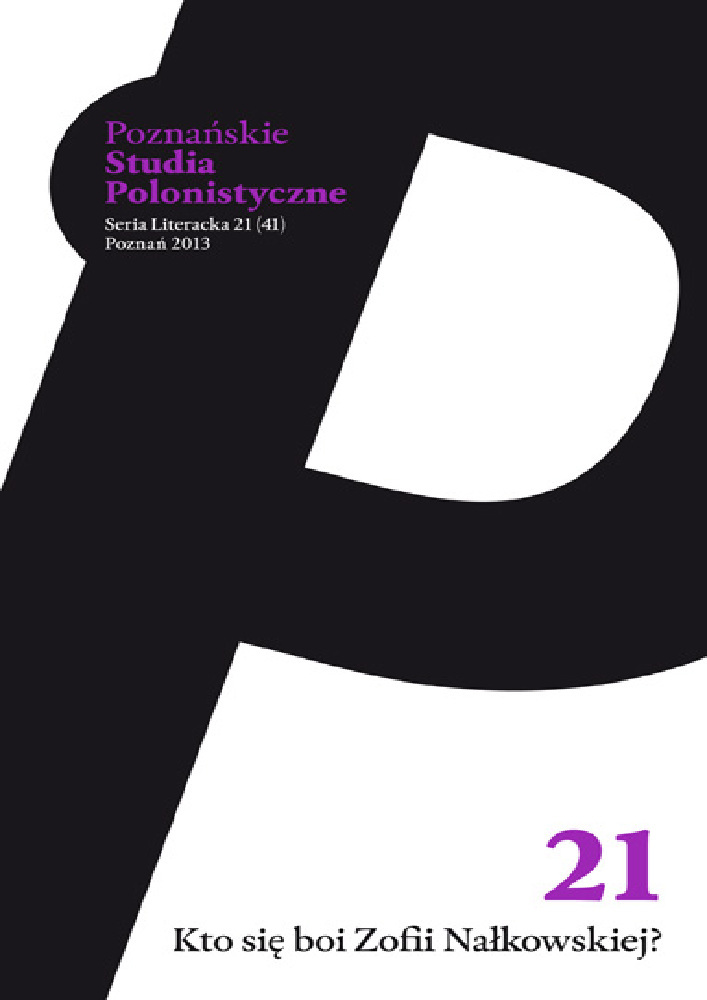Abstract
The article outlines the issue of genre-transformation of tragedy in 19th-century Polish drama. The fundamental question is tragedy’s potential after liberation from the most important structural categories of the genre: the three unities, catharsis and anagnorisis. The discussion on the 19th-century patterns of tragedy, derived from contemporary theory, criticism, and theatrical production, are based on research by Marek Dybizbański, who presented an interesting analysis of the problem, which was an important indicator of contemporary literary thought, in his study called Tragedia polska drugiej połowy XIX wieku — wzorce i odstępstwa [The Polish Tragic Drama in Late 19th Century — Patterns and Divergence]. The issues discussed were: disproportion between expectations and effects, indicated by repertoires and contemporary debate on drama, lack of standard productions of tragedy, matched by great surplus of texts that tried to set the standard, and by programmatic declarations on how to do it. The author, following Dybizbański’s discussion, focuses on the question why the 19th century in Poland was, for tragedy, a lost time.
References
Abramowska J., Ład i Fortuna. O tragedii renesansowej w Polsce, Wrocław 1974.
Bohrer K.H., Groza zjawiska i lęk oczekiwania, w: idem, Absolutna teraźniejszość, przeł. K. Krzemieniowa, Warszawa 2003, s. 33–66.
Dybizbański M., Tragedia polska drugiej połowy XIX wieku — wzorce i odstępstwa, Poznań 2009.
Gutowski W., Młodopolski palimpsest tragiczności, w: Problemy tragedii i tragizmu. Studia I szkice, red. H. Krukowska, J. Ławski, Białystok 2005.
Nowicka E., Klasycyzm i romantyzm — miejsca wspólne? (Arystoteles i przedromantyczne teorie dramatu), w: Nasze pojedynki o romantyzm, red. D. Siwicka, M. Bieńczyk, Warszawa 1995.
Obrusznik-Partyka M., Pozytywistyczne wydziedziczenie tragizmu (?). Rekonesans, w: Problemy tragedii i tragizmu. Studia I szkice, red. H. Krukowska, J. Ławski, Białystok 2005.
Rabski W., Z estrady i sceny. Występy Heleny Modrzejewskiej, „Przegląd Poznański” 1895, nr 4.
Ratajczakowa D., Obrazy narodowe w dramacie i teatrze, Wrocław 1994.
Ratajczakowa D., Wstęp, w: Polska tragedia neoklasycystyczna, oprac. D. Ratajczak, Wrocław 1988.
Sugiera M., Powrót jako trauma, w: eadem, Upiory i inne powroty: pamięć, historia, dramat, Kraków 2006.
Szturc W., Tragedia i jej zanikanie w literaturze polskiej XVIII i XIX wieku. Kilka pytań i kilka odpowiedzi, w: Problemy tragedii i tragizmu. Studia I szkice, red. H. Krukowska, J. Ławski, Białystok 2005.
Teatr Polski w Poznaniu, „Dziennik Poznański” 1899, nr 72.
License
Authors
Authors of texts accepted for publication in „Poznańskie Studia Polonistyczne. Seria Literacka” are required to complete, sign and return to the editor's office the Agreement for granting a royalty-free license to works with a commitment to grant a CC sub-license.
Under the agreement, the authors of texts published in „Poznańskie Studia Polonistyczne. Seria Literacka” grant the Adam Mickiewicz University in Poznań a non-exclusive, royalty-free license and authorize the use of Attribution-NoDerivatives 4.0 International (CC BY-ND 4.0)Creative Commons sub-license.
The authors retain the right to continue the free disposal of the work.
Users
Interested Internet users are entitled to use works published in „Poznańskie Studia Polonistyczne. Seria Literacka” since 2016, for non-commercial purposes only, under the following conditions:
- attribution - obligation to provide, together with the distributed work, information about the authorship, title, source (link to the original work, DOI) and the license itself.
- no derivatives - the work must be preserved in its original form, without the author's consent it is not possible to distribute the modified work, such as translations, publications, etc.
Copyrights are reserved for all texts published before 2016.
Miscellaneous
Adam Mickiewicz University in Poznań retains the right to magazines as a whole (layout, graphic form, title, cover design, logo etc.).
